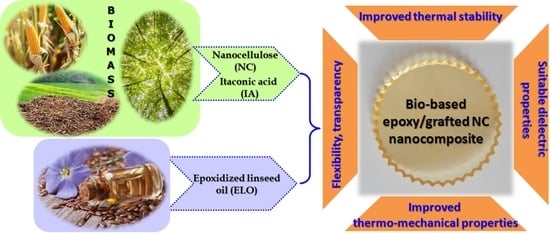Contribution of the Surface Treatment of Nanofibrillated Cellulose on the Properties of Bio-Based Epoxy Nanocomposites Intended for Flexible Electronics
Abstract
1. Introduction
2. Results and Discussion
2.1. FT-IR Spectra of Pristine Materials and Epoxy/NC Nanocomposites
2.2. TMDSC Analysis of the Obtained Epoxy/NC Nanocomposites
2.3. TGA Analysis of Neat Epoxy System and Epoxy/NC Nanocomposites
2.4. DMA Analysis of Neat Epoxy System and Epoxy/NC Nanocomposites
2.5. SEM Analysis of Neat Epoxy System and Epoxy/NC Nanocomposites
2.6. BDS Analysis of Neat Epoxy System and Epoxy/NC Nanocomposites
3. Materials and Methods
3.1. Materials
3.2. Isolation and Surface Treatment of NC
3.3. Preparation of Epoxy System and Epoxy Nanocomposites
3.4. Characterization of Neat Epoxy System and Epoxy/NC Nanocomposites
3.4.1. Fourier-Transformed Infrared (FT-IR) Spectroscopy
3.4.2. Temperature-Modulated Differential Scanning Calorimetry (TMDSC)
3.4.3. Thermogravimetric Analysis (TGA)
3.4.4. Dynamic Mechanical Analysis (DMA)
3.4.5. Transmittance Measurements
3.4.6. Scanning Electron Microscopy (SEM)
3.4.7. Broadband Dielectric Spectroscopy (BDS)
4. Conclusions
Author Contributions
Funding
Institutional Review Board Statement
Informed Consent Statement
Data Availability Statement
Acknowledgments
Conflicts of Interest
References
- Baroncini, E.A.; Yadav, S.K.; Palmese, G.R.; Stanzione, J.F. Recent advances in bio-based epoxy resins and bio-based epoxy curing agents. J. Appl. Polym. Sci. 2016, 133, 44103. [Google Scholar] [CrossRef]
- Ma, S.; Li, T.; Liu, X.; Zhu, J. Research progress on bio-based thermosetting resins. Polym. Int. 2015, 65, 164–173. [Google Scholar] [CrossRef]
- Ocando, C.; Ecochard, Y.; Decostanzi, M.; Caillol, S.; Avérous, L. Dynamic network based on eugenol-derived epoxy as promising sustainable thermoset materials. Eur. Polym. J. 2020, 135, 109860. [Google Scholar] [CrossRef]
- Liu, J.; Wang, S.; Peng, Y.; Zhu, J.; Zhao, W.; Liu, X. Advances in sustainable thermosetting resins: From renewable feedstock to high performance and recyclability. Prog. Polym. Sci. 2021, 113, 101353. [Google Scholar] [CrossRef]
- Rad, E.R.; Vahabi, H.; de Anda, A.R.; Saeb, M.R.; Thomas, S. Bio-epoxy resins with inherent flame retardancy. Prog. Org. Coat. 2019, 135, 608–612. [Google Scholar] [CrossRef]
- Ma, Y.; Liu, H.; Wu, J.; Yuan, L.; Wang, Y.; Du, X.; Wang, R.; Marwa, P.W.; Petlulu, P.; Che, X.; et al. The adverse health effects of bisphenol A and related toxicity mechanisms. Environ. Res. 2019, 176, 108575. [Google Scholar] [CrossRef]
- Waidyanatha, S.; Gaudette, N.F.; Hong, Y.; Fennell, T.R. Formation of Epichlorohydrin, a Known Rodent Carcinogen, Following Oral Administration of 1,3-Dichloro-2-propanol in Rats. Chem. Res. Toxicol. 2014, 27, 1787–1795. [Google Scholar] [CrossRef]
- Nabipour, H.; Wang, X.; Song, L.; Hu, Y. Synthesis of a bio-based and intrinsically anti-flammable epoxy thermoset and the application of its carbonized foam as an efficient CO2 capture adsorbent. Mater. Today Sustain. 2023, 21, 100265. [Google Scholar] [CrossRef]
- Muhamad, M.S.; Salim, M.R.; Lau, W.J.; Yusop, Z. A review on bisphenol A occurrences, health effects and treatment process via membrane technology for drinking water. Environ. Sci. Pollut. Res. 2016, 23, 11549–11567. [Google Scholar] [CrossRef]
- De, B.; Gupta, K.; Mandal, M.; Karak, N. Biodegradable Hyperbranched Epoxy from Castor Oil-Based Hyperbranched Polyester Polyol. ACS Sustain. Chem. Eng. 2014, 2, 445–453. [Google Scholar] [CrossRef]
- Kumar, S.; Samal, S.K.; Mohanty, S.; Nayak, S.N. Curing kinetics of bio-based epoxy resin-toughened DGEBA epoxy resin blend. J. Therm. Anal. Calorim. 2019, 137, 1567–1578. [Google Scholar] [CrossRef]
- Wan, J.; Zhao, J.; Zhang, X.; Fan, H.; Zhang, J.; Hu, D.; Jin, P.; Wang, D.Y. Epoxy thermosets and materials derived from bio-based monomeric phenols: Transformations and performances. Prog. Polym. Sci. 2020, 108, 101287. [Google Scholar] [CrossRef]
- Saikia, A.; Karak, N. Renewable resource based thermostable tough hyperbranched epoxy thermosets as sustainable materials. Polym. Degrad. Stab. 2017, 135, 8–17. [Google Scholar] [CrossRef]
- Schwaiger, M.; Resch-Fauster, K. Mechanical flexible epoxy resins with 100% bio-based carbon content based on epoxidized vegetable oils. J. Appl. Polym. Sci. 2022, 139, e53233. [Google Scholar] [CrossRef]
- Chen, C.H.; Tung, S.H.; Jeng, R.J.; Abu-Omar, M.M.; Lin, C.H. A facile strategy to achieve fully bio-based epoxy thermosets from eugenol. Green Chem. 2019, 21, 4475–4488. [Google Scholar] [CrossRef]
- Reinhardt, N.; Breitsameter, J.M.; Drechsler, K.; Rieger, B. Fully Bio-Based Epoxy Thermoset Based on Epoxidized Linseed Oil and Tannic Acid. Macromol. Mater. Eng. 2022, 307, 2200455. [Google Scholar] [CrossRef]
- Xu, C.; Zheng, Z.; Wu, W.; Fu, L.; Lin, B. Design of healable epoxy composite based on β-hydroxyl esters crosslinked networks by using carboxylated cellulose nanocrystals as crosslinker. Compos. Sci. Technol. 2019, 181, 107677. [Google Scholar] [CrossRef]
- Li, Y.; Xiao, F.; Moon, K.-S.; Wong, C.P. Novel curing agent for lead-free electronics: Amino acid. J. Polym. Sci. Part A Polym. Chem. 2005, 44, 1020–1027. [Google Scholar] [CrossRef]
- Sahoo, S.; Khandelwal, V.; Manik, G. Development of completely bio-based epoxy networks derived from epoxidized linseed and castor oil cured with citric acid. Polym. Adv. Technol. 2018, 29, 2080–2090. [Google Scholar] [CrossRef]
- Di Mauro, C.; Genua, A.; Mija, A. Fully bio-based reprocessable thermosetting resins based on epoxidized vegetable oils cured with itaconic acid. Ind. Crops. Prod. 2022, 185, 115116. [Google Scholar] [CrossRef]
- Lee, S.H.; MdTahir, P.; Lum, W.C.; Tan, L.P.; Bawon, P.; Park, B.-D.; Osman Al Edrus, S.S.; Abdullah, U.H. A Review on Citric Acid as Green Modifying Agent and Binder for Wood. Polymers 2020, 12, 1692. [Google Scholar] [CrossRef] [PubMed]
- Ma, S.; Liu, X.; Jiang, Y.; Tang, Z.; Zhang, C.; Jin, Z. Bio-based epoxy resin from itaconic acid and its thermosets cured with anhydride and comonomers. Green. Chem. 2013, 15, 245–254. [Google Scholar] [CrossRef]
- Naderi, P.; Kabiri, K.; Jahanmardi, R.; Zohuriaan-Mehr, M.J. Preparation of itaconic acid bio-based cross-linkers for hydrogels. J. Macromol. Sci. A. 2020, 58, 165–174. [Google Scholar] [CrossRef]
- Tarabanko, N.; Baryshnikov, S.V.; Kazachenko, A.S.; Miroshnikova, A.V.; Skripnikov, A.M.; Lavrenov, A.V.; Taran, O.P.; Kuznetsov, B.N. Hydrothermal hydrolysis of microcrystalline cellulose from birch wood catalyzed by Al2O3-B2O3 mixed oxides. Wood Sci. Technol. 2022, 56, 437–457. [Google Scholar] [CrossRef]
- Ahmad, H.; Anguilano, L.; Fan, M. Microstructural architecture and mechanical properties of empowered cellulose-based aerogel composites via TEMPO-free oxidation. Carbohydr. Polym. 2022, 298, 120117. [Google Scholar] [CrossRef]
- Abdelhamid, H.N.; Mathew, A.P. Cellulose-Based Nanomaterials Advance Biomedicine: A Review. Int. J. Mol. Sci. 2022, 23, 5405. [Google Scholar] [CrossRef]
- Wang, B.; Zhang, W.; Sun, J.; Lai, C.; Ge, S.; Guo, H.; Liu, Y.; Zhang, D. A micro/nano-multiscale hierarchical structure strategy to fabricate highly conducting films for electromagnetic interference shielding and energy storage. J. Mater. Chem. A 2023, 2050–7488. [Google Scholar] [CrossRef]
- Vatansever, E.; Arslan, D.; Nofar, M. Polylactide cellulose-based nanocomposites. Int. J. Biol. Macromol. 2019, 137, 912–938. [Google Scholar] [CrossRef]
- Frone, A.N.; Panaitescu, D.M.; Chiulan, I.; Gabor, A.R.; Nicolae, C.A.; Oprea, M. Thermal and mechanical behavior of biodegradable polyester films containing cellulose nanofibers. J. Therm. Anal. Calorim. 2019, 138, 2387–2398. [Google Scholar] [CrossRef]
- Zhang, W.; Zhang, G.; Lu, X.-a.; Wang, J.; Wu, D. Cellulosic nanofibers filled poly(β-hydroxybutyrate): Relations between viscoelasticity of composites and aspect ratios of nanofibers. Carbohydr. Polym. 2021, 265, 118093. [Google Scholar] [CrossRef]
- Panaitescu, D.M.; Lupescu, I.; Frone, A.N.; Chiulan, I.; Nicolae, C.A.; Tofan, V.; Stefaniu, A.; Trusca, R. Medium chain-length polyhydroxyalkanoate copolymer modified by bacterial cellulose for medical devices. Biomacromolecules 2017, 18, 3222–3232. [Google Scholar] [CrossRef] [PubMed]
- Platnieks, O.; Sereda, A.; Gaidukovs, S.; Thakur, V.K.; Barkane, A.; Gaidukova, G.M.; Filipova, I.; Ogurcovs, A.; Fridrihsone, V. Adding value to poly (butylene succinate) and nanofibrillated cellulose-based sustainable nanocomposites by applying masterbatch process. Ind. Crops Prod. 2021, 169, 113669. [Google Scholar] [CrossRef]
- Bangar, S.P.; Whiteside, W.S. Nano-cellulose reinforced starch bio composite films—A review on green composites. Int. J. Biol. Macromol. 2021, 185, 849–860. [Google Scholar] [CrossRef] [PubMed]
- Frone, A.N.; Nicolae, C.A.; Gabor, R.A.; Panaitescu, D.M. Thermal properties of water-resistant starch—Polyvinyl alcohol films modified with cellulose nanofibers. Polym. Degrad. Stab. 2015, 121, 385–397. [Google Scholar] [CrossRef]
- Khelifa, F.; Habibi, Y.; Bonnaud, L.; Dubois, P. Epoxy monomers cured by high cellulosic nanocrystals loadings. ACS Appl. Mater. Interfaces 2016, 8, 10535–10544. [Google Scholar] [CrossRef]
- Peng, S.X.; Shrestha, S.; Yoo, Y.; Youngblood, J.P. Enhanced dispersion and properties of a two-component epoxy nanocomposite using surface modified cellulose nanocrystals. Polymer 2017, 112, 359–368. [Google Scholar] [CrossRef]
- Zhao, J.; Li, Q.; Zhang, X.; Xiao, M.; Zhang, W.; Lu, C. Grafting of polyethylenimine onto cellulose nanofibers for interfacial enhancement in their epoxy nanocomposites. Carbohydr. Polym. 2017, 157, 1419–1425. [Google Scholar] [CrossRef]
- Laghaei, R.; Hejazi, S.M.; Fashandi, H.; Akbarzadeh, S.; Shaghaghi, S.; Shamaei-Kashani, A.; Jahanara, B.; Shahsavari, E. Reinforcement contribution of cellulose nanocrystals (CNCs) to tensile properties and fracture behavior of triaxial E-glass fabric/epoxy composites. Compos. Part A Appl. Sci. Manuf. 2023, 164, 107258. [Google Scholar] [CrossRef]
- Trinh, B.M.; Mekonnen, T. Hydrophobic esterification of cellulose nanocrystals for epoxy reinforcement. Polymer 2018, 155, 64–74. [Google Scholar] [CrossRef]
- Yeo, J.; Kim, O.Y.; Hwang, S. The effect of chemical surface treatment on the fracture toughness of microfibrillated cellulose reinforced epoxy composites. J. Ind. Eng. Chem. 2017, 45, 301–306. [Google Scholar] [CrossRef]
- Emami, Z.; Meng, Q.; Pircheraghi, G.; Manas-Zloczower, I. Use of surfactants in cellulose nanowhisker/epoxy nanocomposites: Effect on filler dispersion and system properties. Cellulose 2015, 22, 3161–3176. [Google Scholar] [CrossRef]
- Shibata, M.; Teramoto, N.; Makino, K. Preparation and Properties of Biocomposites Composed of Epoxidized Soybean Oil, Tannic Acid, and Microfibrillated Cellulose. J. Appl. Polym. Sci. 2011, 120, 273–278. [Google Scholar] [CrossRef]
- Shibata, M.; Nakai, K. Preparation and Properties of Biocomposites Composed of Bio-Based Epoxy Resin, Tannic Acid, and Microfibrillated Cellulose. J. Polym. Sci. B Polym. Phys. 2010, 48, 425–433. [Google Scholar] [CrossRef]
- Wu, G.; Liu, D.; Liu, G.; Chen, J.; Huo, S.; Kong, Z. Thermoset nanocomposites from waterborne bio-based epoxy resin and cellulose nanowhiskers. Carbohydr. Polym. 2015, 127, 229–235. [Google Scholar] [CrossRef] [PubMed]
- Kwon, Y.R.; Kim, H.C.; Kim, J.S.; Chang, Y.W.; Park, H.; Kim, D.H. Itaconic-acid-based superabsorbent polymer with high gel strength and biocompatibility. Polym. Int. 2022, 71, 1090–1098. [Google Scholar] [CrossRef]
- Ge, H.; Hua, T.; Wang, J. Preparation and characterization of poly (itaconic acid)-grafted crosslinked chitosan nanoadsorbent for high uptake of Hg2+ and Pb2+. Int. J. Biol. Macromol. 2017, 95, 954–961. [Google Scholar] [CrossRef]
- Necolau, M.I.; Damian, C.M.; Olaret, E.; Iovu, H.; Balanuca, B. Comparative Thermo-Mechanical Properties of Sustainable Epoxy Polymer Networks Derived from Linseed Oil. Polymers 2022, 14, 4212. [Google Scholar] [CrossRef]
- Ding, C.; Peter, S.; Shuttleworth, P.S.; Makin, S.; Clark, J.H.; Avtar, S.; Matharu, A.S. New insights into the curing of epoxidized linseed oil with dicarboxylic acids. Green Chem. 2015, 17, 4000–4008. [Google Scholar] [CrossRef]
- Todorovic, A.; Resch-Fauster, K.; Mahendran, A.R.; Oreski, G.; Kern, W. Curing of epoxidized linseed oil: Investigation of the curing reaction with different hardener types. J. Appl. Polym. Sci. 2021, 138, 50239. [Google Scholar] [CrossRef]
- Hameed, N.; Bavishi, J.; Parameswaranpillai, J.; Salim, N.V.; Joseph, J.; Madrasd, G.; Foxab, B.L. Thermally flexible epoxy/cellulose blends mediated by an ionic liquid. RSC Adv. 2015, 65, 52832–52836. [Google Scholar] [CrossRef]
- Thompson, L.; Nikzad, M.; Sbarski, I.; Yu, A. Esterified cellulose nanocrystals for reinforced epoxy nanocomposites. Prog. Nat. Sci. 2022, 32, 328–333. [Google Scholar] [CrossRef]
- Roszowska-Jarosz, M.; Masiewicz, J.; Kostrzewa, M.; Kucharczyk, W.; Zurowski, W.; Kucińska-Lipka, J.; Przybyłek, P. Mechanical Properties of Bio-Composites Based on Epoxy Resin and Nanocellulose Fibres. Materials 2021, 14, 3576. [Google Scholar] [CrossRef] [PubMed]
- Yu, Q.; Liang, Y.; Cheng, J.; Chen, S.; Zhang, A.; Miao, M.; Zhang, D. Synthesis of a Degradable High-Performance Epoxy-Ended Hyperbranched Polyester. ACS Omega 2017, 2, 1350–1359. [Google Scholar] [CrossRef] [PubMed]
- Saba, N.; Safwan, A.; Sanyang, M.L.; Mohammad, F.; Pervaiz, M.; Jawaid, M.; Alothman, O.Y.; Sain, M. Thermal and dynamic mechanical properties of cellulose nanofibers reinforced epoxy composites. Int. J. Biol. Macromol. 2017, 102, 822–828. [Google Scholar] [CrossRef] [PubMed]
- Nair, S.S.; Kuo, P.Y.; Chen, H.; Yan, N. Investigating the effect of lignin on the mechanical, thermal, and barrier properties of cellulose nanofibril reinforced epoxy composite. Ind. Crops Prod. 2017, 100, 208–217. [Google Scholar] [CrossRef]
- Pandurangan, M.T.; Kanny, K. Study of Curing Characteristics of Cellulose Nanofiber-Filled Epoxy Nanocomposites. Catalysts 2020, 10, 831. [Google Scholar] [CrossRef]
- Neves Monteiro, S.; Salgado de Assis, F.; Ferreira, C.L.; Tonini Simonassi, N.; Pondé Weber, R.; Souza Oliveira, M.; Colorado, H.A.; Camposo Pereira, A. Fique Fabric: A Promising Reinforcement for Polymer Composites. Polymers 2018, 10, 246. [Google Scholar] [CrossRef]
- Nair, S.S.; Dartiailh, C.; Levin, D.B.; Yan, N. Highly Toughened and Transparent Biobased Epoxy Composites Reinforced with Cellulose Nanofibrils. Polymers 2019, 11, 612. [Google Scholar] [CrossRef]
- Lee, K.; Kwon, G.; Jeon, Y.; Jeon, S.; Hong, C.; Choung, J.W.; You, J. Toward millimeter thick cellulose nanofiber/epoxy laminates with good transparency and high flexural strength. Carbohydr. Polym. 2022, 291, 119514. [Google Scholar] [CrossRef]
- Fan, X.; Miao, J.-T.; Yuan, L.; Guan, Q.; Gu, A.; Liang, G. Preparation and origin of thermally resistant biobased epoxy resin with low internal stress and good UV resistance based on SiO2 hybridized cellulose for light emitting diode encapsulation. Appl. Surf. Sci. 2018, 447, 315–324. [Google Scholar] [CrossRef]
- Voo, R.; Mariatti, M.; Sim, L. Flexibility improvement of epoxy nanocomposites thin films using various flexibilizing additives. Compos. B Eng. 2012, 43, 3037–3043. [Google Scholar] [CrossRef]
- Unnikrishnan, K.P.; Thachil, E.T. Toughening of epoxy resins. Des. Monomers Polym. 2006, 9, 129–152. [Google Scholar] [CrossRef]
- Necolau, M.; Balanuca, B.; Frone, A.N.; Damian, C.M. Tailoring an effective interface between nanocellulose and epoxidized linseed oil network through functionalization. ACS Omega 2022. submitted. [Google Scholar]
- Singha, S.; Thomas, M.J. Dielectric properties of epoxy nanocomposites. IEEE Trans. Dielectr. Electr. Insul. 2008, 15, 12–23. [Google Scholar] [CrossRef]
- Wang, Y.; Zhu, L.; Zhou, J.; Jia, B.; Jiang, Y.; Wang, J. Dielectric properties and thermal conductivity of epoxy resin composite modified by Zn/ZnO/Al2O3 core–shell particles. Polym. Bull. 2019, 76, 3957–3970. [Google Scholar] [CrossRef]
- Qiang, D.; Wang, Y.; Chen, G.; Andritsch, T. Dielectric properties of epoxy silica and boron nitride nanocomposites and moisture/temperature influences. IET Nanodielectr. 2018, 1, 48–59. [Google Scholar] [CrossRef]
- Zafar, R.; Gupta, N. Dielectric spectroscopy of epoxy-based barium titanate nanocomposites: Effect of temperature and humidity. IET Nanodielectrics 2020, 3, 20–27. [Google Scholar] [CrossRef]
- Min, D.; Cui, H.; Hai, Y.; Li, P.; Xing, Z.; Zhang, C.; Li, S. Interfacial regions and network dynamics in epoxy/POSS nanocomposites unravelling through their effects on the motion of molecular chains. Compos. Sci. Technol. 2020, 199, 108329. [Google Scholar] [CrossRef]
- Sevasti, G.; Stavropoulos, S.; Sanida, A.; Psarras, G. A comparative study on the thermomechanical and electrical properties of carbide/or graphite/epoxy-reinforced composites. J. Therm. Anal. Calorim. 2020, 142, 1649–1657. [Google Scholar] [CrossRef]
- Popa, M.S.; Frone, A.N.; Radu, I.C.; Stanescu, P.O.; Truşcă, R.; Rădiţoiu, V.; Nicolae, C.A.; Gabor, A.R.; Panaitescu, D.M. Microfibrillated Cellulose Grafted with Metacrylic Acid as a Modifier in Poly(3-hydroxybutyrate). Polymers 2021, 13, 3970. [Google Scholar] [CrossRef]
- Flory, P.J. Baker lectures 1948, George Fisher Baker non-resident lectureship in chemistry at Cornell University, The Baker lectures. In Principles of Polymer Chemistry; Cornell University Press: New York, NY, USA, 1953. [Google Scholar]
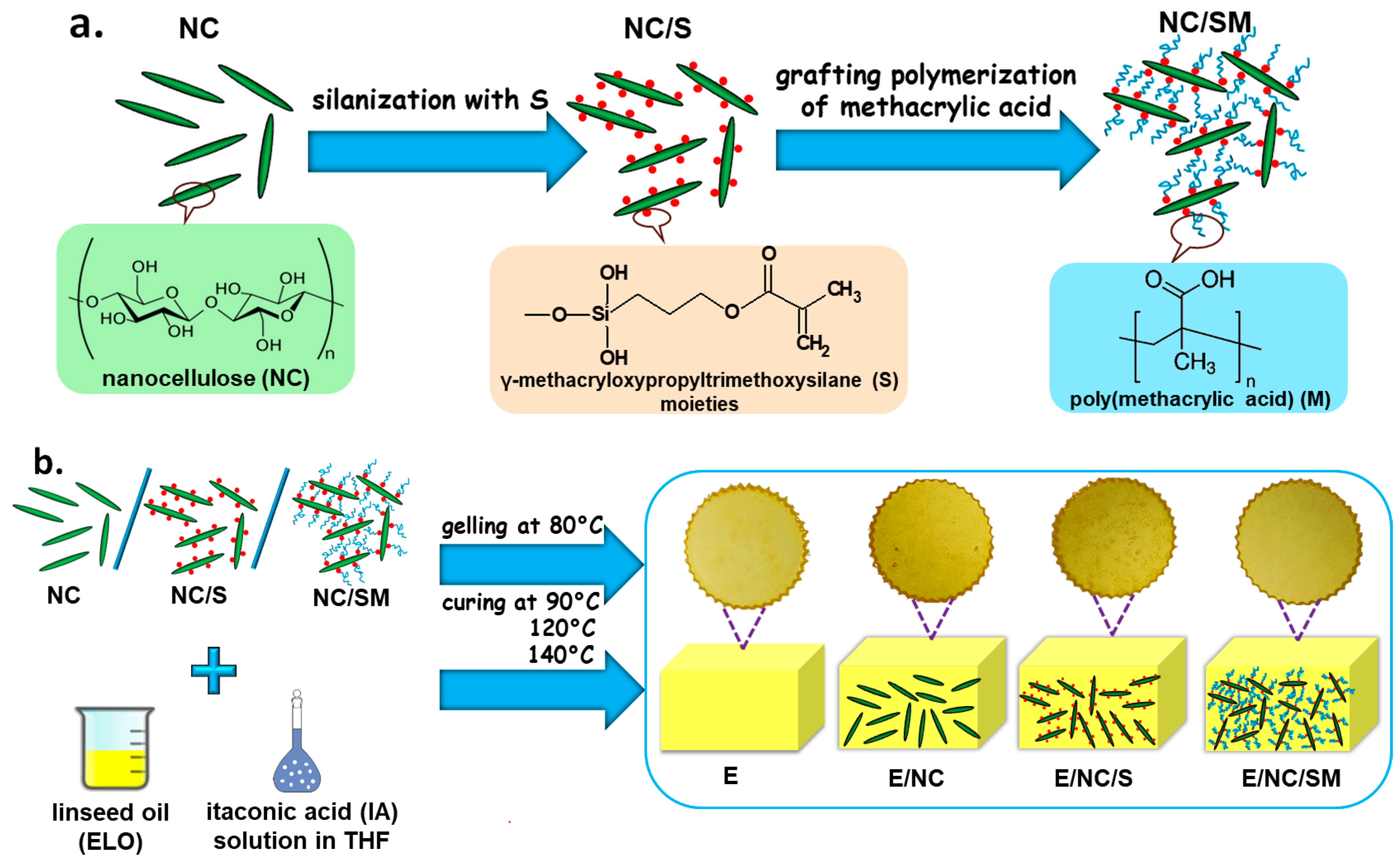
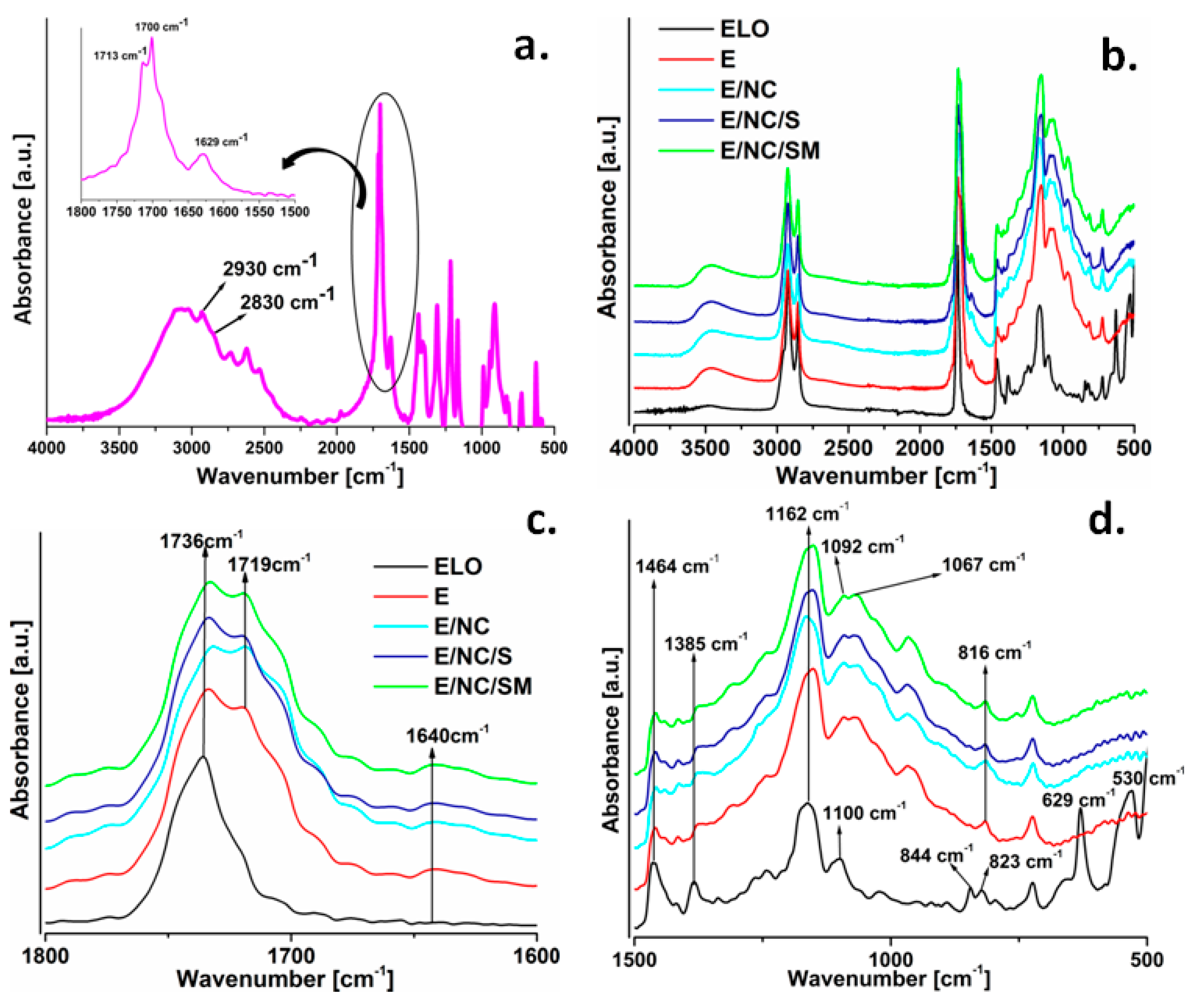
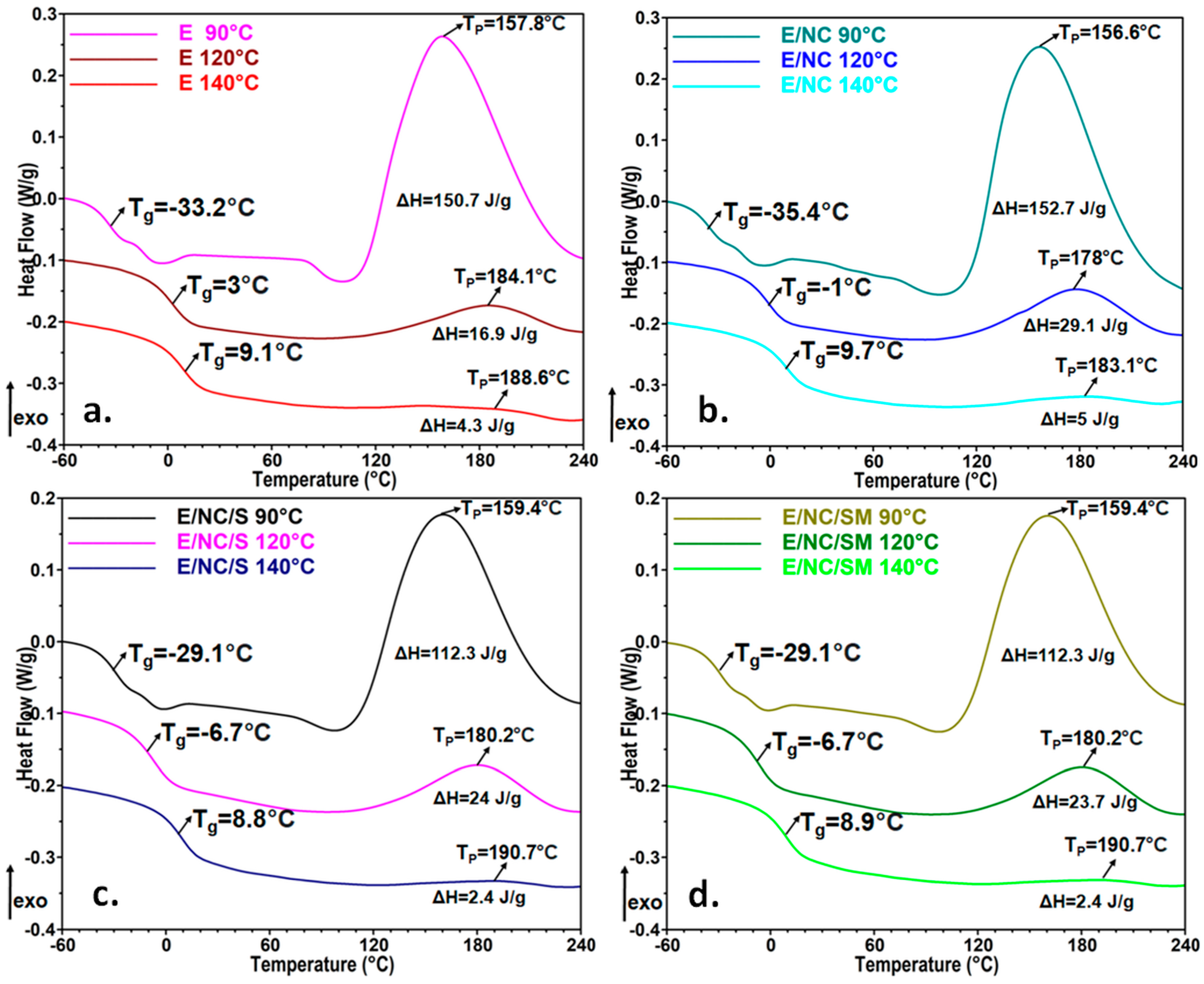
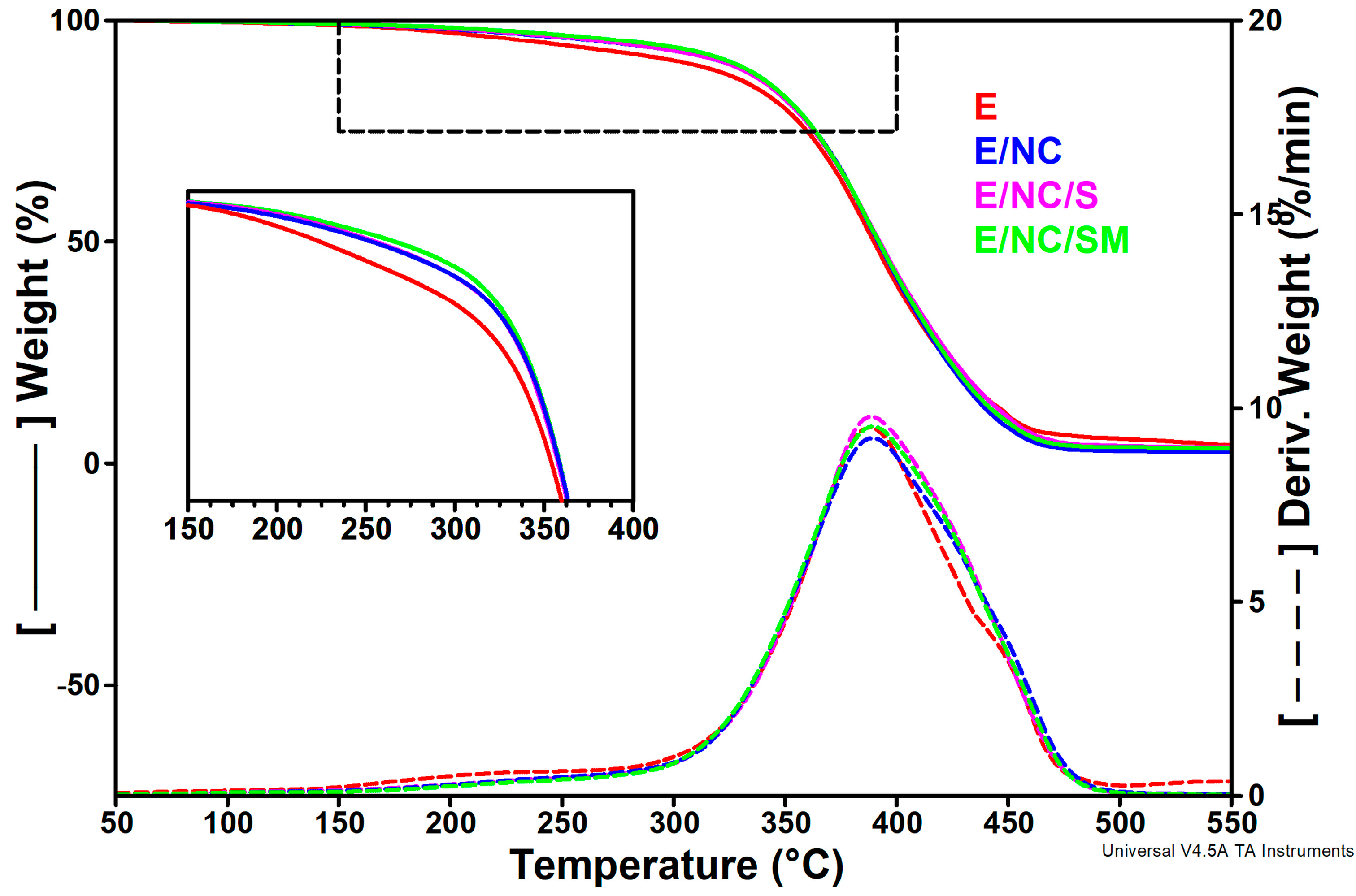
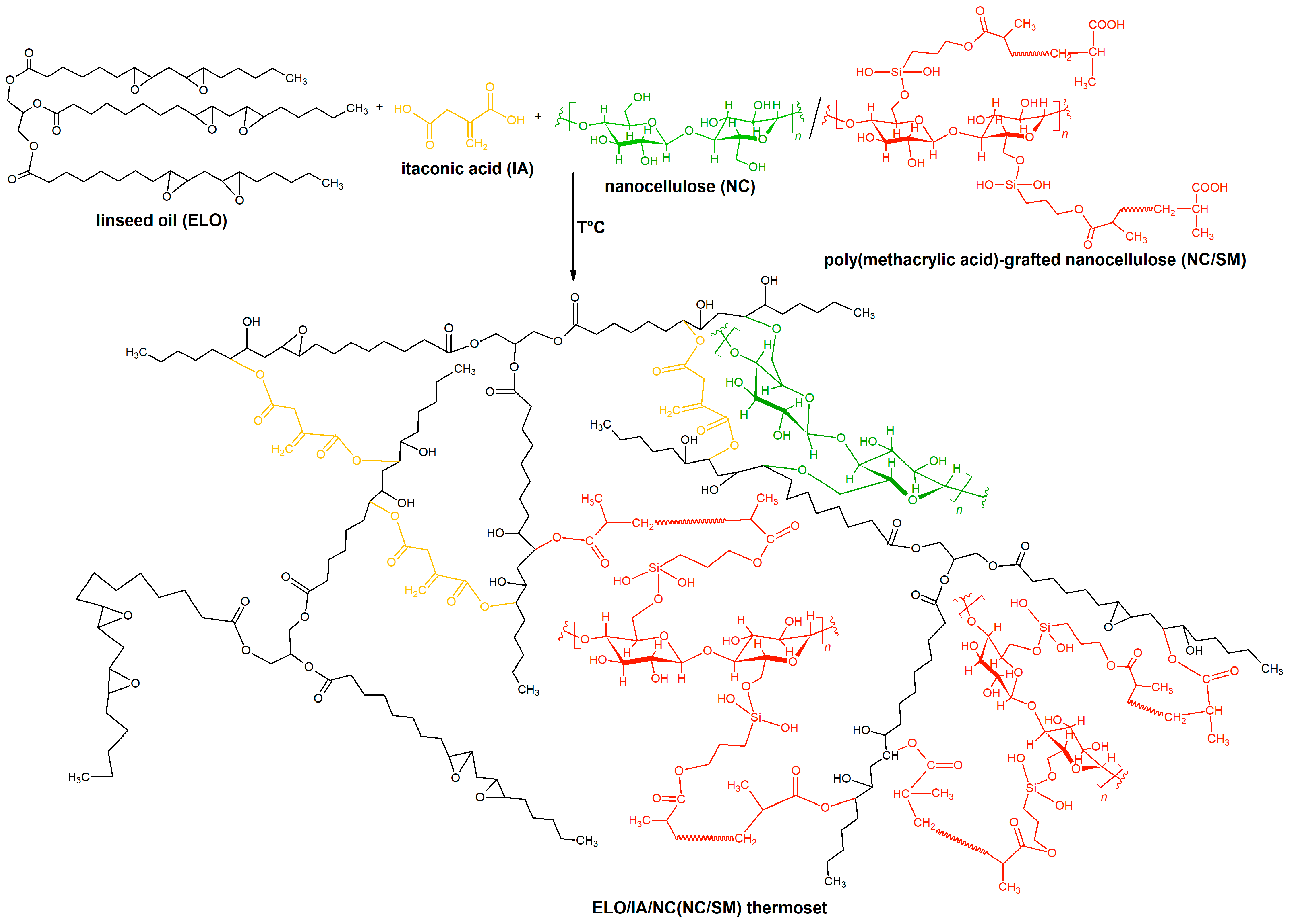
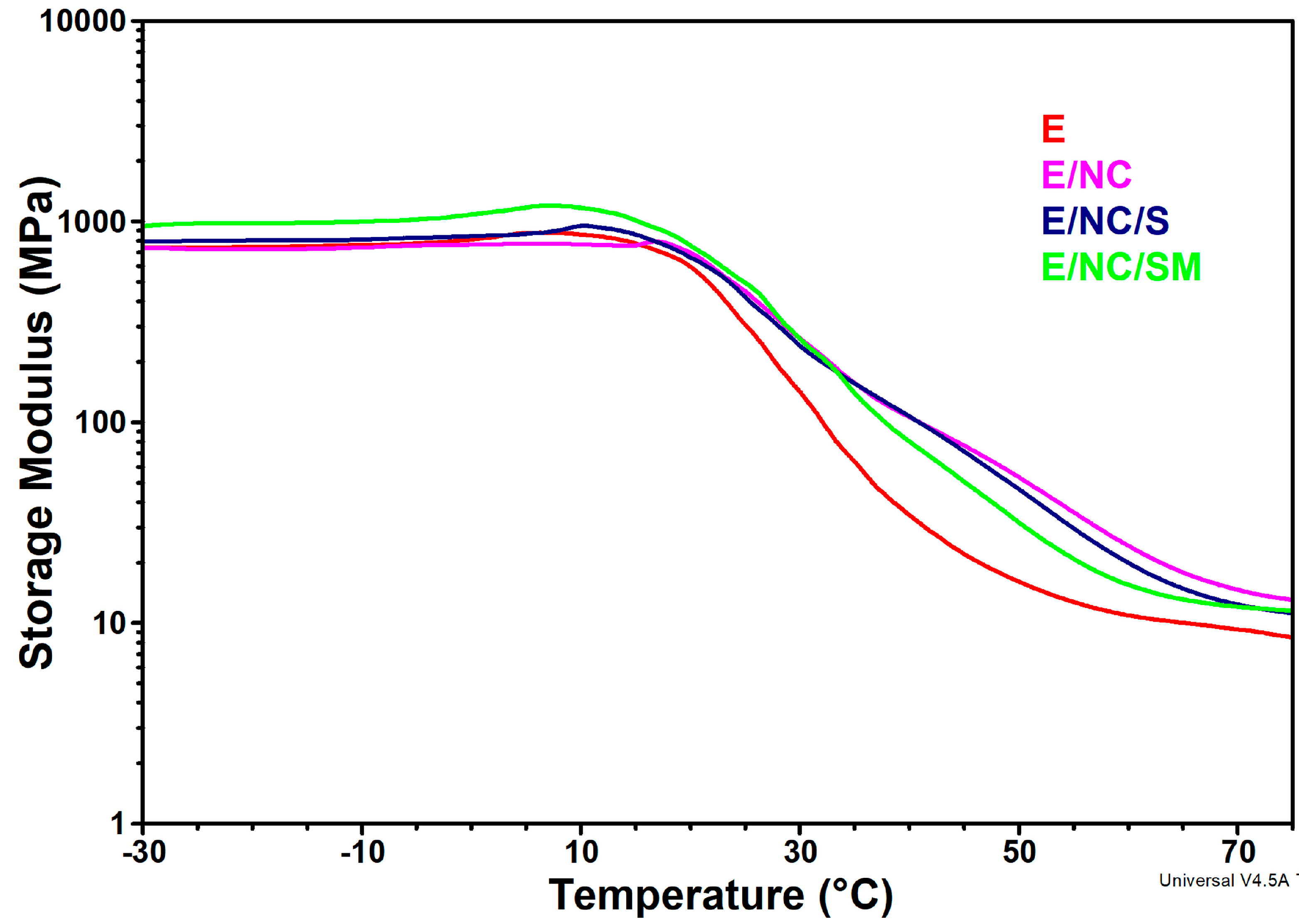


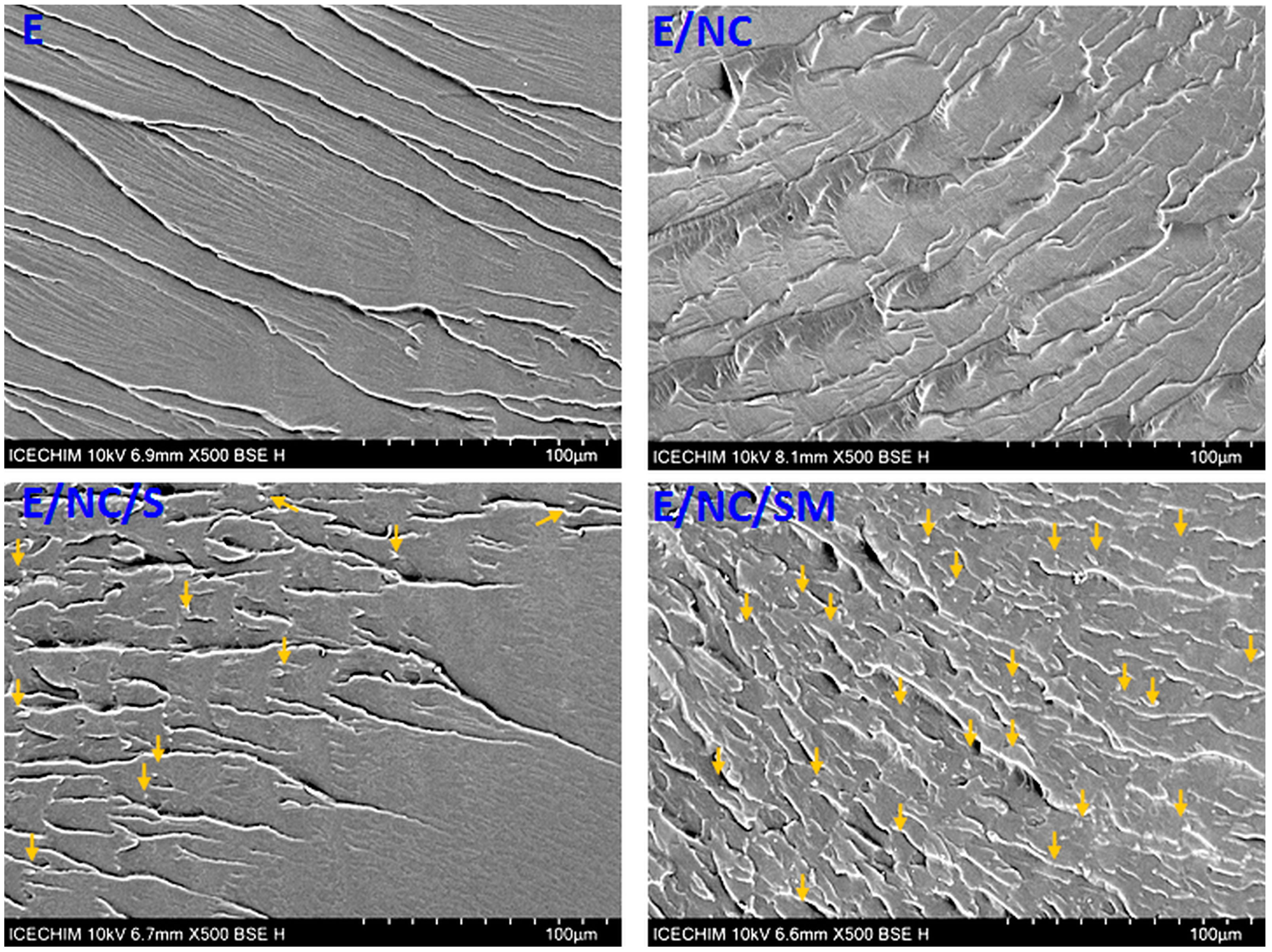
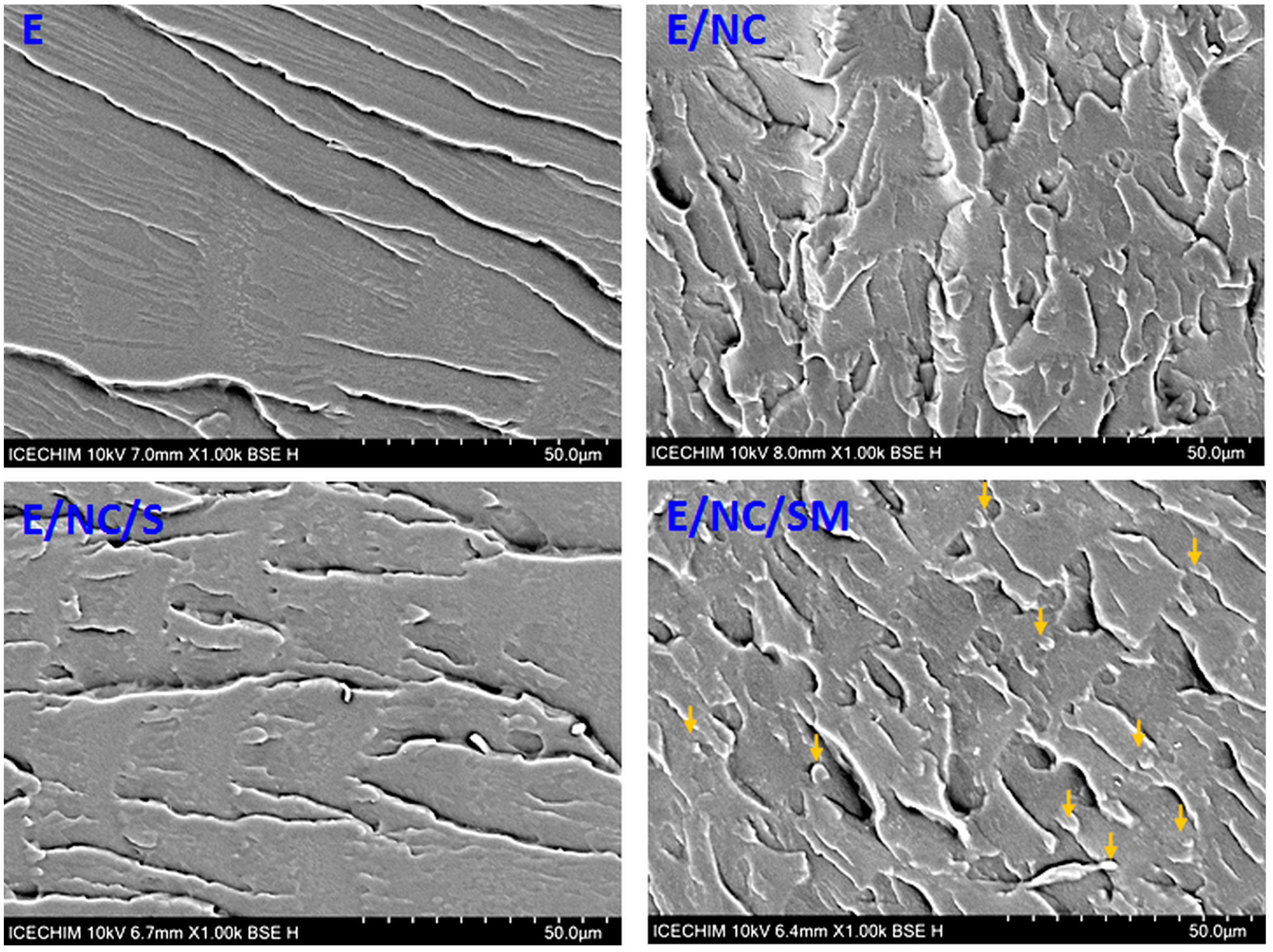
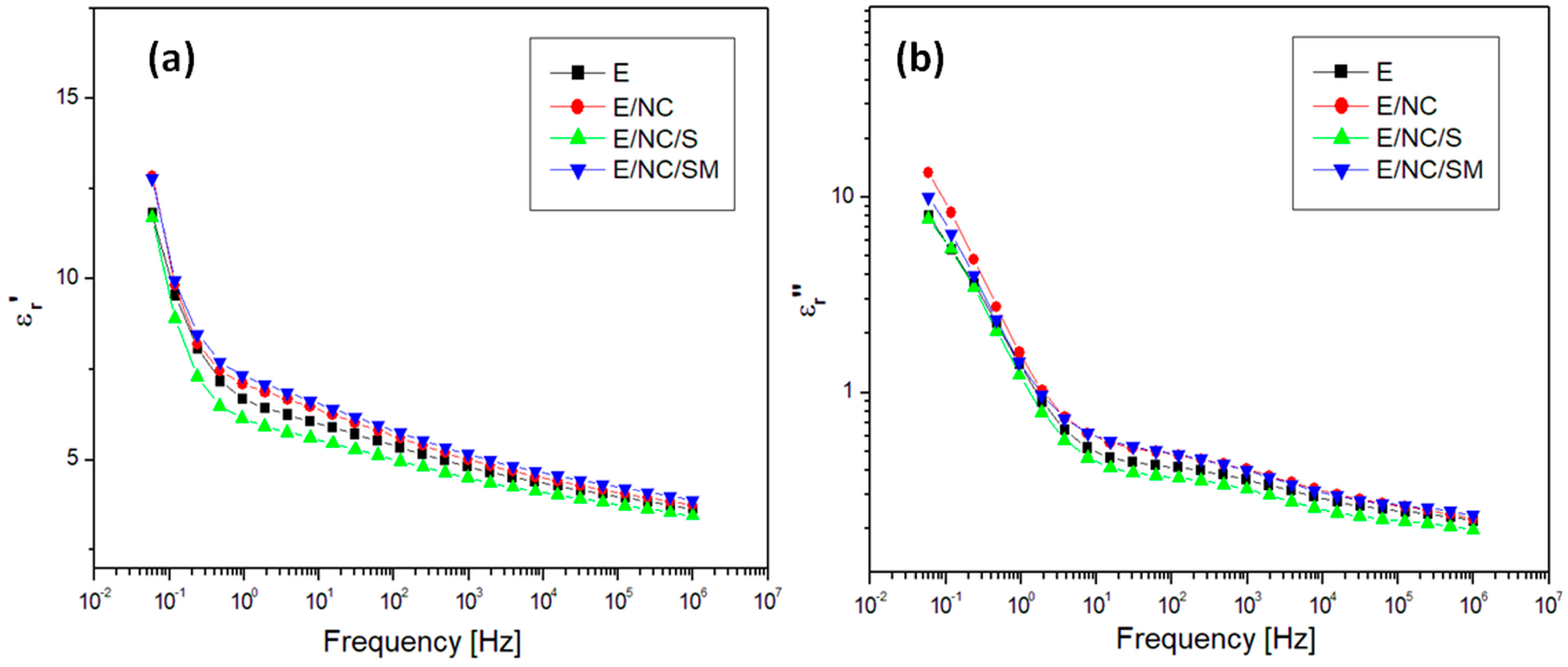
| Sample | Td,5%, °C | Td,max, °C | WL200°C % | R750°, % |
|---|---|---|---|---|
| E | 240.3 ± 4.95 | 387.7 ± 0.49 | 2.78 ± 0.6 | 0.04 |
| E/NC | 271.8 ± 2.33 | 388.8 ± 2.05 | 1.98 ± 0.13 | 0.33 |
| E/NC/S | 272.9 ± 2.26 | 388.8 ± 0.64 | 1.83 ± 0.12 | 1.52 |
| E/NC/SM | 284.2 ± 3.82 | 389.4 ± 1.91 | 1.64 ± 0.24 | 0.86 |
| Samples | E’−25°C (MPa) | E’0°C (MPa) | E’25°C (MPa) | E’50°C (MPa) | Tg,E’ (°C) | Crosslink Density (mmol cm−3) | tan δmax |
|---|---|---|---|---|---|---|---|
| E | 745.9 | 814.1 | 315.2 | 16.0 | 22.9 | 1.02 | 0.74 |
| E/NC | 729.7 | 770.3 | 455.1 | 53.2 | 28.1 | 1.43 | 0.47 |
| E/NC/S | 801.3 | 846.1 | 409.5 | 46.4 | 24.4 | 1.30 | 0.43 |
| E/NC/SM | 977.6 | 1087 | 506.2 | 31.7 | 19.9 | 1.41 | 0.47 |
| Sample Code | ELO | NC | NC/S | NC/SM | Curing Conditions |
|---|---|---|---|---|---|
| E | yes | - | - | - | 90 °C, 90 min; 120 °C, 60 min; 140 °C, 60 min |
| E/NC | yes | yes | - | ||
| E/NC/S | yes | yes | - | ||
| E/NC/SM | yes | - | - | yes |
Disclaimer/Publisher’s Note: The statements, opinions and data contained in all publications are solely those of the individual author(s) and contributor(s) and not of MDPI and/or the editor(s). MDPI and/or the editor(s) disclaim responsibility for any injury to people or property resulting from any ideas, methods, instructions or products referred to in the content. |
© 2023 by the authors. Licensee MDPI, Basel, Switzerland. This article is an open access article distributed under the terms and conditions of the Creative Commons Attribution (CC BY) license (https://creativecommons.org/licenses/by/4.0/).
Share and Cite
Frone, A.N.; Uşurelu, C.D.; Oprică, G.M.; Panaitescu, D.M.; Gabor, A.R.; Nicolae, C.-A.; Ciuprina, F.; Damian, C.M.; Raduly, F.M. Contribution of the Surface Treatment of Nanofibrillated Cellulose on the Properties of Bio-Based Epoxy Nanocomposites Intended for Flexible Electronics. Int. J. Mol. Sci. 2023, 24, 6544. https://doi.org/10.3390/ijms24076544
Frone AN, Uşurelu CD, Oprică GM, Panaitescu DM, Gabor AR, Nicolae C-A, Ciuprina F, Damian CM, Raduly FM. Contribution of the Surface Treatment of Nanofibrillated Cellulose on the Properties of Bio-Based Epoxy Nanocomposites Intended for Flexible Electronics. International Journal of Molecular Sciences. 2023; 24(7):6544. https://doi.org/10.3390/ijms24076544
Chicago/Turabian StyleFrone, Adriana Nicoleta, Cătălina Diana Uşurelu, Gabriela Mădălina Oprică, Denis Mihaela Panaitescu, Augusta Raluca Gabor, Cristian-Andi Nicolae, Florin Ciuprina, Celina Maria Damian, and Florentina Monica Raduly. 2023. "Contribution of the Surface Treatment of Nanofibrillated Cellulose on the Properties of Bio-Based Epoxy Nanocomposites Intended for Flexible Electronics" International Journal of Molecular Sciences 24, no. 7: 6544. https://doi.org/10.3390/ijms24076544
APA StyleFrone, A. N., Uşurelu, C. D., Oprică, G. M., Panaitescu, D. M., Gabor, A. R., Nicolae, C.-A., Ciuprina, F., Damian, C. M., & Raduly, F. M. (2023). Contribution of the Surface Treatment of Nanofibrillated Cellulose on the Properties of Bio-Based Epoxy Nanocomposites Intended for Flexible Electronics. International Journal of Molecular Sciences, 24(7), 6544. https://doi.org/10.3390/ijms24076544






